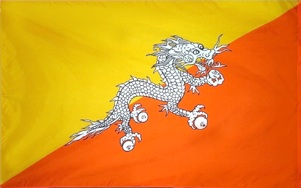Balkans 2016
Balkans 2016 Albania Kosovo Macedonia

Bhutan
2018
It’s hard to believe that my time in Bhutan has come to a finish; my nine days has passed all too quickly. The time has flown because Bhutan is one of those rare countries that has what I call the “fabulous three” – a combination of spectacular natural landscapes, a vibrant and intact natural culture, and genuinely wonderful people.
This morning’s breakfast was, unfortunately, as bad as last night’s dinner was great. It didn’t really matter as last night’s dinner of Indian food had been SO good, probably our best meal in Bhutan, so we didn’t need much to eat anyway.
We left the hotel at 8:30am for the short 10 minute drive to the airport. Our Bhutan Airlines flight to Kolkata was scheduled to depart at 10:35am, and given the small size of Paro Airport and its friendly, efficient procedures, this was plenty of time. Indeed, the only difficult part of our time at the airport was saying farewell to our excellent guide, Dhendup, and our brilliant driver, Tinlay. They were superb hosts during our stay, and it was a genuinely sad experience to have to say goodbye. I hope we can maintain contact with them, especially if they manage to get to Australia one day as they both hope to do.
Our Bhutan Airlines Airbus A319 looked resplendent in the morning light as we walked across the tarmac to board our flight. As often seems to happen with flights from Paro, our flight pushed back early and we were soon climbing sharply through a series of S-bends as we flew south through the Paro Chhu valley, mountain sides seeming to almost touch us from above on both sides of the plane.
Our short flight to Kolkata was pleasant. Despite only being 50 minutes duration, drinks and a snack were served, and we landed 20 minutes ahead of schedule at 10:55am. The heat, bustle, noise and aromas of Kolkata as I travelled into the city centre from the airport were an immediate contrast with the cool serenity left behind in Bhutan. Kolkata was to be quite a different experience from Bhutan, and within just a few hours of landing I found myself undertaking some research on self-help initiatives to promote development in the city’s slum areas.
Although my daily diaries for this trip have emphasised the experiences of travelling in Bhutan, my real motive for coming to Bhutan was less recreational. I was interested in researching two main geographical aspects of the country – its commitment to sustainable development (as shown through its unique concept of Gross National Happiness, or GNH), and its uniquely sustainable approach to tourism. The travel experiences were simply the breathtaking icing on the cake.
Would I recommend travel to Bhutan? Without a doubt – yes! It is truly one of the world’s great travel destinations, which makes the widespread ignorance of Bhutan outside the country all the more puzzling. Maybe the country needs better marketing for its tourism, although of course that would undermine its commitment to sustainable tourism by limiting numbers.
Tourist numbers are also limited by the high cost of travelling here – the minimum spending requirement of US$250 per person per day. This sum covers everything, including visa, all internal travel, accommodation, entry fees, three buffet meals per day, and guide and driver. Nonetheless, given the low costs that generally prevail in Bhutan, there is a substantial profit margin in this sum, especially when several people are travelling together.
And this is where tourism links to GNH. Tourism is Bhutan’s second highest source of foreign income after its sales of hydro-electricity to India, and income from tourism is thus a major source of funding for Bhutan’s development and welfare systems.
Everyone in Bhutan receives free education, including postgraduate education outside Bhutan if a student has the ability. Furthermore, everyone in Bhutan receives free health care, including visits to the doctor, hospital stays, surgery, and even treatment overseas (usually India but sometimes elsewhere such as Singapore). This expensive social welfare program, which forms a key foundation of GNH, is paid for by the revenues from hydro-electricity sales and income from tourism.
Before I came, I half-jokingly hoped that my visit to Bhutan would enhance GNH, not diminish it. Now that I understand a little more about the distinctive practical workings of Bhutan’s economy, and the link between tourism and GNH, I am more comfortable that my visit benefitted the Bhutanese just as it certainly benefitted my own education as a life-long learner.

Day 9 - Leaving Bhutan
Friday 6 April 2018












